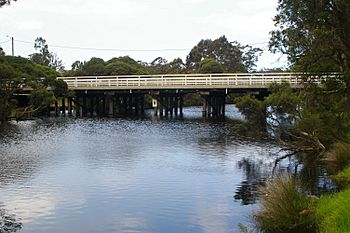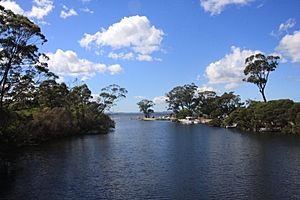Denmark River facts for kids
Quick facts for kids Denmark River |
|
|---|---|

|
|
| Country | Australia |
| Physical characteristics | |
| Main source | near Pardelup 160 metres (525 ft) |
| River mouth | Wilson Inlet |
| Length | 60 kilometres (37 mi) |
| Basin features | |
| Basin size | 800 square kilometres (309 sq mi) |
The Denmark River is a beautiful waterway in the Great Southern part of Western Australia. It starts near a place called Pardelup. From there, it gently winds its way south.
Finally, the river flows through the town of Denmark. It then joins the Wilson Inlet, a large body of water, along with the Hay River.
The original people of this land are the Noongar people. They have a special name for the river: Kwoorabup. This name means "the place of the Western brush wallaby" or "the place we return to."
Contents
How the Denmark River Got Its Name
The Denmark River got its English name in December 1829. A naval ship's surgeon named Thomas Braidwood Wilson gave it this name. He named it after his mentor, a naval surgeon named Alexander Denmark. Alexander Denmark was a very important doctor in the navy.
Wilson discovered the river while exploring the area. He was with a local Noongar guide named Mokare and other people. This happened while his ship, the Governor Phillips, was being fixed at King George Sound.
In 1833, a surveyor noted that the local Noongar people called the river "Koorrabup." This name meant "place of the black swan."
The River's Journey
The Denmark River flows through a place called Denmark Pipehead Dam. This dam helps manage the river's water. The river also has two smaller streams, or tributaries, that flow into it. These are Scotsdale Brook and Cleerillup Creek.
In 2011, the southern part of the river became protected. This was thanks to a plan by the Denmark Shire Council. This area is very important to the Noongar people. They have used it for over 10,000 years. It is a place for dancing, singing, preparing for marriage, and gathering food.
The area is also culturally important because of its connection to the Wagyl. The Wagyl is a powerful rainbow serpent in Noongar Dreaming stories. It is believed to have created the rivers and waterways.
The River's Amazing Comeback
What is Salinity?
Salinity means how much salt is in the water. For a long time, the water quality of the Denmark River got worse. This happened because a lot of land was cleared in the area. When land is cleared, more salt can wash into the river.
In the 1940s, the river had only a little salt. But by 1987, the salt levels were much higher. This was a big problem for the river's health.
How the River Got Better
Something amazing happened in 2004! Experts announced that the salt levels in the river were actually going down. This was a huge deal. It was believed to be the first major river in Australia to show such a big improvement. People hoped the river could even provide drinking water again in the future.
By 2012, the average salt levels had dropped even more. They were now low enough to meet the World Health Organization guidelines for drinking water. This was the first time in almost 40 years!
Because the water quality improved, Denmark Dam is now used again for drinking water. It also serves as a back-up water supply for the town of Denmark.
Why the River Improved
The main reason for this drop in salt is replanting. Farmers planted many Tasmanian blue gum trees on land that was cleared before. These trees help to soak up water from the ground. This stops the salt from reaching the river. It's a great example of how replanting trees can help our environment!



